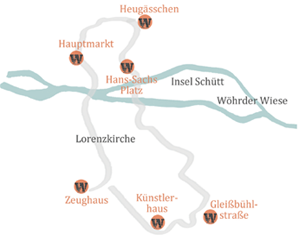Tour
Search for traces of resistance against the Nazi regime in contemporary Nuremberg. Learn about people that took a stand against the regime—in various ways. We suggest taking the subway to either Hauptbahnhof or Lorenzkirche. All stations of the tour can be reached by foot.
Suggestion for a tour (1 to 1.5 hours):
Start your tour at the central station (Hauptbahnhof). When entering the old town, across the mighty Königsturm (king’s tower), you’ll find an elongated building with a concrete-glass-cube. It was build as a house of artists by a foundation of Nuremberg citizens. After World War II, the US Army used it as officer’s casino. After that, it became a temporary location for the University until it was dedicated as a self-administered cultural centre (KOMM). Today, several clubs and associations reside here, as well as some of the city’s cultural institutions and the restaurant Auguste.
Now, follow Königstraße until you meet the Mauthalle, continuing left. Here at the Hallplatz, the Zeughaus was located (in former times the armory).. The remaining building is but a glimpse of a former building complex that was destroyed in the Second World War. Now, a police station is housed here.
Following the pedestrian area, you’ll reach the main marketplace (Hauptmarkt). During the NS regime, this place was named after Adolf Hitler. Devastated by bombings, the Schöne Brunnen (beautiful well) was surrounded by debris and open spaces. Of the historical buildings, only a few remained.
The stairs at the place’s Northern side pass by the registry office and the Restaurant Bratwurst Röslein. At the Fünferplatz, turn into the Bindergasse. The Heugässchen on the right takes you to the Sebalder Hofgärtchen.. Ludwigstraße and the Café Merk do not exist anymore. The area was converted to a housing area. Located in the middle of this residential area, the inner courtyard holds the Sebalder Hofgärtchen, an urban gardening project by the environmental NGO Bund für Umwelt- und Naturschutz (BUND).
Following the Heugässchen slightly downhill, you will arrive at the Hans-Sachs-Platz (with a monument of Hans Sachs, a poet from Nuremberg). On the Southern side, the Heilig-Geist-Spital dominates the square. Vis-à-vis, right beside where the Café Katz is today, the main Synagogue once stood. Already a few weeks before the Reichspogromnacht in November 1938, the NS regime decided to tear down the Synagogue. Today, residential and commercial buildings stand here. A monument beside the Heubrücke reminds of the Synagogue.
Crossing the Insel Schütt (insula Schütt), past the multiplex cinema Cinecitta, the City Library and the parking deck Katharinenhof, head for the Lorenzer Straße. Cross the Königstorgraben at the Kunsthalle. You’ll reach the next setting at Gleißbühlstraße when you turn right at the next crossing. The former apartment blocks were replaced with modern commercial buildings over the past decades. There’s not much left of old structures that might remind us of former times.
Following the street, you’ll soon reach the tour’s starting point, the central station.


 Deutsch
Deutsch